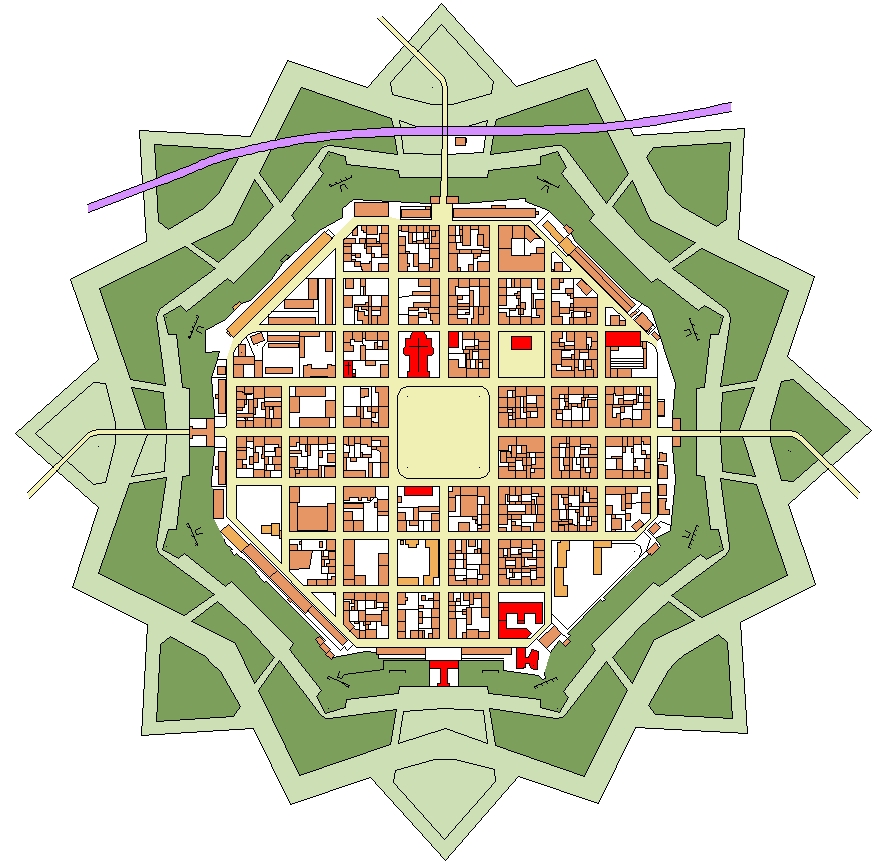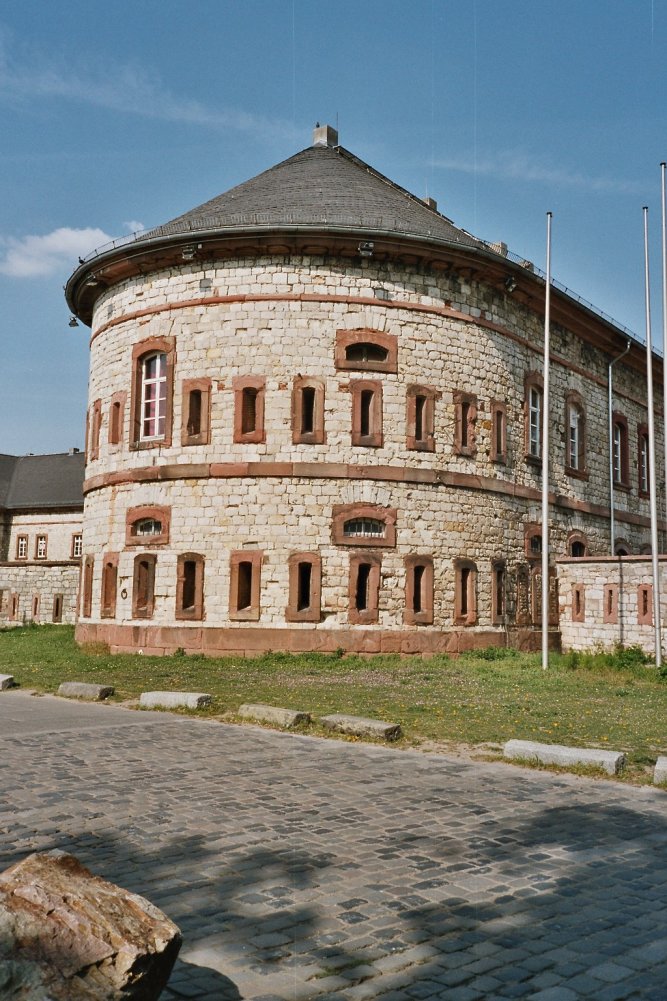|
Neuf-Brisach, France
Neuf-Brisach ( or ; ; gsw-FR, Nei-Brisach) is a fortified town and commune of the department of Haut-Rhin in the French region of Alsace. The fortified town was intended to guard the border between France and the Holy Roman Empire and, subsequently, the German states. It was built after the Treaty of Ryswick in 1697 that resulted in France losing the town of Breisach, on the opposite bank of the Rhine. The town's name means ''New Breisach''. Today the town is a UNESCO World Heritage Site because of quintessential military fortifications and its testimony to the influence of Vauban on military architecture during the 17-19th centuries. History Work began on the fortified town in 1698, to plans drawn by Vauban, a military engineer at the service of Louis XIV. Vauban died in 1707 and this, his last work, was completed by Louis de Cormontaigne. The city's layout was that of an 'ideal city', as was popular at the time, with a regular square grid street pattern inside a ... [...More Info...] [...Related Items...] OR: [Wikipedia] [Google] [Baidu] |
Communes Of France
The () is a level of administrative division in the French Republic. French are analogous to civil townships and incorporated municipalities in the United States and Canada, ' in Germany, ' in Italy, or ' in Spain. The United Kingdom's equivalent are civil parishes, although some areas, particularly urban areas, are unparished. are based on historical geographic communities or villages and are vested with significant powers to manage the populations and land of the geographic area covered. The are the fourth-level administrative divisions of France. vary widely in size and area, from large sprawling cities with millions of inhabitants like Paris, to small hamlets with only a handful of inhabitants. typically are based on pre-existing villages and facilitate local governance. All have names, but not all named geographic areas or groups of people residing together are ( or ), the difference residing in the lack of administrative powers. Except for the municipal arrondi ... [...More Info...] [...Related Items...] OR: [Wikipedia] [Google] [Baidu] |
Communes Of Haut-Rhin
The following is a list of the 366 communes of the French department of Haut-Rhin. The communes cooperate in the following intercommunalities (as of 2020):BANATIC Périmètre des EPCI à fiscalité propre. Accessed 3 July 2020. *CA *CA *CA * [...More Info...] [...Related Items...] OR: [Wikipedia] [Google] [Baidu] |
Communes Of The Haut-Rhin Department
The following is a list of the 366 communes of the French department of Haut-Rhin. The communes cooperate in the following intercommunalities (as of 2020):BANATIC Périmètre des EPCI à fiscalité propre. Accessed 3 July 2020. *CA *CA *CA * [...More Info...] [...Related Items...] OR: [Wikipedia] [Google] [Baidu] |
Sébastien Le Prestre De Vauban
Sébastien Le Prestre de Vauban, Seigneur de Vauban, later Marquis de Vauban (baptised 15 May 163330 March 1707), commonly referred to as ''Vauban'' (), was a French military engineer who worked under Louis XIV. He is generally considered the greatest engineer of his time, and one of the most important in European military history. His principles for fortifications were widely used for nearly 100 years, while aspects of his offensive tactics remained in use until the mid-twentieth century. He viewed civilian infrastructure as closely connected to military effectiveness and worked on many of France's major ports, as well as projects like the Canal de la Bruche, which remain in use today. He founded the , whose curriculum was based on his publications on engineering design, strategy and training. His economic tract, , used statistics in support of his arguments, making it a precursor of modern economics. Later destroyed by royal decree, it contained radical proposals for a more ... [...More Info...] [...Related Items...] OR: [Wikipedia] [Google] [Baidu] |
Louis Schlaefli
Louis Schlaefli (4 December 1938, Neuf-BrisachLouis Schlaefli, « À Neuf-Brisach en 1944-45 : simples souvenirs d'un enfant », in ''Annuaire de la Société d'histoire de la Hardt et du Ried'', 2002, n°15, ) is a Franco-Swiss scholar, collector, and librarian. Since 1964 he has been the librarian of the Sainte-Marie-Majeure Seminary in Strasbourg, for which he composed several major catalogs. He is also the author of more than five hundred articles and contributions related to the heritage and history of Alsace, mostly religious ones.Jean-Marie Le Minor, « Louis Schlaefli », in ''Nouveau dictionnaire de biographie alsacienne'', Fédération des sociétés d'histoire et d'archéologie d'Alsace, 2006, vol. 47, Selected publications Detailed references of about 300 of these 500 publications by Louis Schlaefli are included in the online catalog of the National and University Library in Strasbourg. * ''Les Publications de la Grande congrégation académique de Molsheim Mol ... [...More Info...] [...Related Items...] OR: [Wikipedia] [Google] [Baidu] |
French Revolutionary Wars
The French Revolutionary Wars (french: Guerres de la Révolution française) were a series of sweeping military conflicts lasting from 1792 until 1802 and resulting from the French Revolution. They pitted French First Republic, France against Kingdom of Great Britain, Britain, Habsburg monarchy, Austria, Kingdom of Prussia, Prussia, Russian Empire, Russia, and several other monarchies. They are divided in two periods: the War of the First Coalition (1792–97) and the War of the Second Coalition (1798–1802). Initially confined to Europe, the fighting gradually assumed a global dimension. After a decade of constant warfare and aggressive diplomacy, France had conquered territories in the Italian Peninsula, the Low Countries and the Rhineland in Europe and abandoned Louisiana (New France), Louisiana in North America. French success in these conflicts ensured the spread of revolutionary principles over much of Europe. As early as 1791, the other monarchies of Europe looked with ou ... [...More Info...] [...Related Items...] OR: [Wikipedia] [Google] [Baidu] |
François-Joseph Offenstein
François-Joseph is a given name, and may refer to: * François-Joseph Amon d'Aby (1913–2007), Ivoirian playwright and essayist * François-Joseph de Beaupoil de Sainte-Aulaire (1643-1742), French poet and army officer * François-Joseph Bélanger (1744-1818), French architect and decorator * François-Joseph Bérardier de Bataut (1720-1794), French teacher, writer and translator * François-Joseph Bissot (1673–1737), Canadian merchant, navigator and a co-seigneur of Mingan; son of François Byssot de la Rivière * François-Joseph Bressani (1612-1672), Jesuit priest * Général François-Joseph Chaussegros de Léry (1754-1824), Canadian Engineer-in-Chief and Commander-in-Chief of Napoleon's Armies Armies in Holland * François-Joseph d'Offenstein (1760-1837), French general and military commander * François-Joseph de Champagny (1804–1882), French author and historian * François-Joseph Duret (1732-1816), French sculptor * François-Joseph Fétis (1784-1871), Belgian music ... [...More Info...] [...Related Items...] OR: [Wikipedia] [Google] [Baidu] |
Fortifications Of Vauban
A fortification is a military construction or building designed for the defense of territories in warfare, and is also used to establish rule in a region during peacetime. The term is derived from Latin ''fortis'' ("strong") and ''facere'' ("to make"). From very early history to modern times, defensive walls have often been necessary for cities to survive in an ever-changing world of invasion and conquest. Some settlements in the Indus Valley civilization were the first small cities to be fortified. In ancient Greece, large stone walls had been built in Mycenaean Greece, such as the ancient site of Mycenae (famous for the huge stone blocks of its 'cyclopean' walls). A Greek '' phrourion'' was a fortified collection of buildings used as a military garrison, and is the equivalent of the Roman castellum or English fortress. These constructions mainly served the purpose of a watch tower, to guard certain roads, passes, and borders. Though smaller than a real fortress, they acted ... [...More Info...] [...Related Items...] OR: [Wikipedia] [Google] [Baidu] |
World War II
World War II or the Second World War, often abbreviated as WWII or WW2, was a world war that lasted from 1939 to 1945. It involved the vast majority of the world's countries—including all of the great powers—forming two opposing military alliances: the Allies and the Axis powers. World War II was a total war that directly involved more than 100 million personnel from more than 30 countries. The major participants in the war threw their entire economic, industrial, and scientific capabilities behind the war effort, blurring the distinction between civilian and military resources. Aircraft played a major role in the conflict, enabling the strategic bombing of population centres and deploying the only two nuclear weapons ever used in war. World War II was by far the deadliest conflict in human history; it resulted in 70 to 85 million fatalities, mostly among civilians. Tens of millions died due to genocides (including the Holocaust), starvation, ma ... [...More Info...] [...Related Items...] OR: [Wikipedia] [Google] [Baidu] |
Covered Way
In military architecture, a covertway or covered way (french: chemin couvert it, strada coperta) is a path on top of the counterscarp of a fortification. It is protected by an embankment which is made up by the crest of the glacis. It is able to give the fort's garrison a position beyond the ditch, as well as a continuous line of communication around the outworks. An enlarged area within a covertway designed to allow troops to assemble on it is known as a place-of-arms A place-of-arms ( it, piazza d'armi, french: place d'armes) is any place in a fortification where troops can gather. The term has a number of meanings, but it generally refers to an enlarged area of the covertway designed as an assembly point fo .... References Fortification (architectural elements) {{fort-stub ... [...More Info...] [...Related Items...] OR: [Wikipedia] [Google] [Baidu] |
Reduit
A reduit is a fortified structure such as a citadel or a keep into which the defending troops can retreat when the outer defences are breached. The term is also used to describe an area of a country, which, through a ring of heavy fortifications or through enhancing through fortification the defences offered by natural features such as mountains, will be defended even when the rest of the country is occupied by a hostile power. . An entry for this word was first included in New English Dictionary, 1904. *1948 Times 31 Dec. 3/3 "The obsolete conception of a national reduit has been abandoned in favour of an extra-territorial base established in the Belgian Congo". *2003 Macpherson ''Amer. Intelligence War-time London'' vi. 177 "As for the Reduit (or Redoubt), this was the rumoured area for 'a last-ditch stand' in the Bavarian, Austrian and Italian Alps". National Reduit In English the term National redoubt is fairly commonly used. A redoubt is an outlying fortification, so its ... [...More Info...] [...Related Items...] OR: [Wikipedia] [Google] [Baidu] |




